Stuart Carruthers's Blog, page 2
January 1, 2013
12 Letters That Didn’t Make the English Alphabet
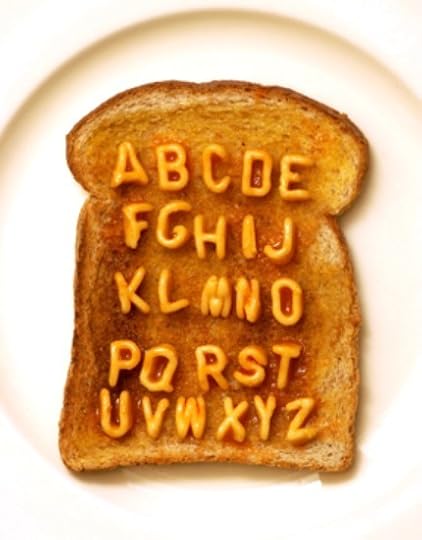
Taken from Mental Floss
12 Letters That Didn’t Make the English Alphabet You know the alphabet. It’s one of the first things you’re taught in school. But did you know that they’re not teaching you all of the alphabet? There are quite a few letters we tossed aside as our language grew, and you probably never even knew they existed.1. Thorn
 Have you ever seen a place that calls itself “ye olde whatever”? As it happens, that’s not a “y”, or, at least, it wasn’t supposed to be. Originally, it was an entirely different letter called thorn, which derived from the Old English runic alphabet, Futhark.Thorn, which was pronounced exactly like the “th” in its name, is actually still around today in Icelandic. We replaced it with “th” over time—thorn fell out of use because Gothic-style scripting made the letters y and thorn look practically identical. And, since French printing presses didn’t have thorn anyway, it just became common to replace it with a y. Hence naming things like, “Ye Olde Magazine of Interesting Facts” (just as an example, of course).2. Wynn
Have you ever seen a place that calls itself “ye olde whatever”? As it happens, that’s not a “y”, or, at least, it wasn’t supposed to be. Originally, it was an entirely different letter called thorn, which derived from the Old English runic alphabet, Futhark.Thorn, which was pronounced exactly like the “th” in its name, is actually still around today in Icelandic. We replaced it with “th” over time—thorn fell out of use because Gothic-style scripting made the letters y and thorn look practically identical. And, since French printing presses didn’t have thorn anyway, it just became common to replace it with a y. Hence naming things like, “Ye Olde Magazine of Interesting Facts” (just as an example, of course).2. Wynn
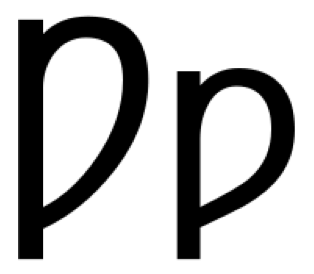 Another holdover from the Futhark runic alphabet, wynn was adapted to the Latin alphabet because it didn’t have a letter that quite fit the “w” sound that was common in English. You could stick two u’s (technically v’s, since Latin didn’t have u either) together, like in equus, but that wasn’t exactly right.Over time, though, the idea of sticking two u’s together actually became quite popular, enough so that they literally became stuck together and became the letter W (which, you’ll notice, is actually two V’s).3. Yogh
Another holdover from the Futhark runic alphabet, wynn was adapted to the Latin alphabet because it didn’t have a letter that quite fit the “w” sound that was common in English. You could stick two u’s (technically v’s, since Latin didn’t have u either) together, like in equus, but that wasn’t exactly right.Over time, though, the idea of sticking two u’s together actually became quite popular, enough so that they literally became stuck together and became the letter W (which, you’ll notice, is actually two V’s).3. Yogh
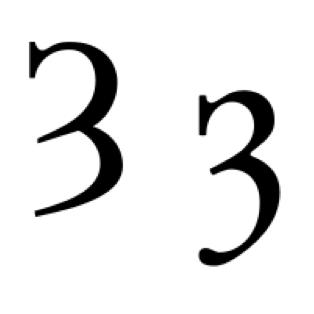 Yogh stood for a sort of throaty noise that was common in Middle English words that sounded like the “ch” in “Bach” or Scottish “loch.”French scholars weren’t fans of our weird non-Latin letters and started replacing all instances of yogh with “gh” in their texts. When the throaty sound turned into “f” in Modern English, the “gh”s were left behind.”4. Ash
Yogh stood for a sort of throaty noise that was common in Middle English words that sounded like the “ch” in “Bach” or Scottish “loch.”French scholars weren’t fans of our weird non-Latin letters and started replacing all instances of yogh with “gh” in their texts. When the throaty sound turned into “f” in Modern English, the “gh”s were left behind.”4. Ash
 You’re probably familiar with this guy from old-fashioned Greek or Roman style text, especially the kind found in churches. It’s even still used stylistically in words today, like æther and æon.What you may not know, however, is that at one time the ae grapheme (as it’s now known) was an honorary English letter back in the days of Old English. It still had the same pronunciation and everything, it was just considered to be part of the alphabet and called “æsc” or “ash” after the ash Futhark rune, for which it was used as a substitute when transcribing into Latin letters.5. Eth
You’re probably familiar with this guy from old-fashioned Greek or Roman style text, especially the kind found in churches. It’s even still used stylistically in words today, like æther and æon.What you may not know, however, is that at one time the ae grapheme (as it’s now known) was an honorary English letter back in the days of Old English. It still had the same pronunciation and everything, it was just considered to be part of the alphabet and called “æsc” or “ash” after the ash Futhark rune, for which it was used as a substitute when transcribing into Latin letters.5. Eth
 Eth is kind of like the little brother to thorn. Originating from Irish, it was meant to represent a slightly different pronunciation of the “th” sound, more like that in “thought” or “thing” as opposed to the one found in “this” or “them.” (The first is the voiceless dental fricative, the second is the voiced dental fricative).Note that, depending on your regional accent, there may not be much of a difference (or any at all) in the two pronunciations anyway, but that’s Modern English. Back in the old days, the difference was much more distinct. As such, you’d often see texts with both eth and thorn depending on the required pronunciation. Before too long, however, people just began using thorn for both (and later “th”) and so eth slowly became unnecessary.6. Ampersand
Eth is kind of like the little brother to thorn. Originating from Irish, it was meant to represent a slightly different pronunciation of the “th” sound, more like that in “thought” or “thing” as opposed to the one found in “this” or “them.” (The first is the voiceless dental fricative, the second is the voiced dental fricative).Note that, depending on your regional accent, there may not be much of a difference (or any at all) in the two pronunciations anyway, but that’s Modern English. Back in the old days, the difference was much more distinct. As such, you’d often see texts with both eth and thorn depending on the required pronunciation. Before too long, however, people just began using thorn for both (and later “th”) and so eth slowly became unnecessary.6. Ampersand
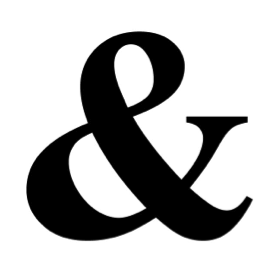 Today we just use it for stylistic purposes (and when we’ve run out of space in a text message or tweet), but the ampersand has had a long and storied history in English, and was actually frequently included as a 27th letter of the alphabet as recently as the 19th century.In fact, it’s because of its placement in the alphabet that it gets its name. Originally, the character was simply called “and” or sometimes “et” (from the Latin word for and, which the ampersand is usually stylistically meant to resemble). However, when teaching children the alphabet, the & was often placed at the end, after Z, and recited as “and per se and,” meaning “and in and of itself” or “and standing on its own.”So you’d have “w, x, y, z, and, per se, and.” Over time, the last bit morphed into “ampersand,” and it stuck even after we quit teaching it as part of the alphabet.7. Insular G
Today we just use it for stylistic purposes (and when we’ve run out of space in a text message or tweet), but the ampersand has had a long and storied history in English, and was actually frequently included as a 27th letter of the alphabet as recently as the 19th century.In fact, it’s because of its placement in the alphabet that it gets its name. Originally, the character was simply called “and” or sometimes “et” (from the Latin word for and, which the ampersand is usually stylistically meant to resemble). However, when teaching children the alphabet, the & was often placed at the end, after Z, and recited as “and per se and,” meaning “and in and of itself” or “and standing on its own.”So you’d have “w, x, y, z, and, per se, and.” Over time, the last bit morphed into “ampersand,” and it stuck even after we quit teaching it as part of the alphabet.7. Insular G
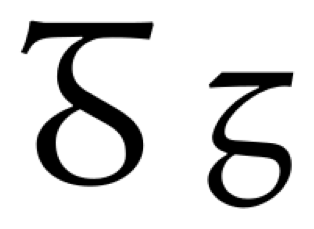 This letter (referred to as “insular G” or “Irish G” because it didn’t have a fancy, official name) is sort of the grandfather of the Middle English version of yogh. Originally an Irish letter, it was used for the previously mentioned zhyah/jhah pronunciation that was later taken up by yogh, though for a time both were used.It also stood alongside the modern G (or Carolingian G) for many centuries, as they represented separate sounds. The Carolingian G was used for hard G sounds, like growth or good, yogh was used for “ogh” sounds, like cough or tough, and insular g was used for words like measure or vision.As Old English transformed into Middle English, insular G was combined with yogh and, as mentioned earlier, was slowly replaced with the now-standard “gh” by scribes, at which point insular G/yogh were no longer needed and the Carolingian G stood alone (though the insular G is still used in modern Irish).8. “That”
This letter (referred to as “insular G” or “Irish G” because it didn’t have a fancy, official name) is sort of the grandfather of the Middle English version of yogh. Originally an Irish letter, it was used for the previously mentioned zhyah/jhah pronunciation that was later taken up by yogh, though for a time both were used.It also stood alongside the modern G (or Carolingian G) for many centuries, as they represented separate sounds. The Carolingian G was used for hard G sounds, like growth or good, yogh was used for “ogh” sounds, like cough or tough, and insular g was used for words like measure or vision.As Old English transformed into Middle English, insular G was combined with yogh and, as mentioned earlier, was slowly replaced with the now-standard “gh” by scribes, at which point insular G/yogh were no longer needed and the Carolingian G stood alone (though the insular G is still used in modern Irish).8. “That”
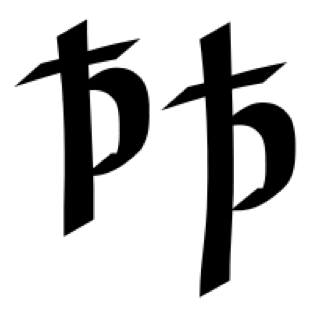 Much like the way we have a symbol/letter for “and,” we also once had a similar situation with “that,” which was a letter thorn with a stroke at the top. It was originally just a shorthand, an amalgamation of thorn and T (so more like “tht”), but it eventually caught on and got somewhat popular in its own right (even outliving thorn itself), especially with religious institutions. There’s an excellent chance you can find this symbol somewhere around any given church to this day.9. Ethel
Much like the way we have a symbol/letter for “and,” we also once had a similar situation with “that,” which was a letter thorn with a stroke at the top. It was originally just a shorthand, an amalgamation of thorn and T (so more like “tht”), but it eventually caught on and got somewhat popular in its own right (even outliving thorn itself), especially with religious institutions. There’s an excellent chance you can find this symbol somewhere around any given church to this day.9. Ethel
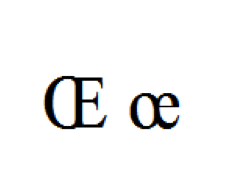 Similar to Æ/ash/æsc above, the digraph for OE was once considered to be a letter as well, called ethel. It wasn’t named after someone’s dear, sweet grandmother, but the Furthark rune Odal, as œ was its equivalent in transcribing.It was traditionally used in Latin loan words with a long e sound, such as subpœna or fœtus. Even federal was once spelled with an ethel. (Fœderal.) These days, we’ve just replaced it with a simple e.10. Tironian “Ond”
Similar to Æ/ash/æsc above, the digraph for OE was once considered to be a letter as well, called ethel. It wasn’t named after someone’s dear, sweet grandmother, but the Furthark rune Odal, as œ was its equivalent in transcribing.It was traditionally used in Latin loan words with a long e sound, such as subpœna or fœtus. Even federal was once spelled with an ethel. (Fœderal.) These days, we’ve just replaced it with a simple e.10. Tironian “Ond”
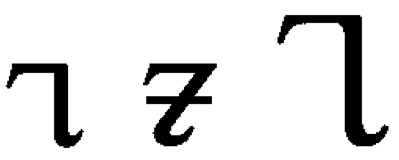 Long before there were stenographers, a Roman by the name of Marcus Tullius Tiro (who was basically Roman writer Cicero’s P.A.) invented a shorthand system called Tironian notes. It was a fairly simple system that was easily expanded, so it remained in use by scribes for centuries after Tiro’s death.One of the most useful symbols (and an ancestor to the ampersand) was the “et” symbol above—a simple way of tossing in an “and.” (And yes, it was sometimes drawn in a way that’s now a popular stylistic way of drawing the number 7.) When used by English scribes, it became known as “ond,” and they did something very clever with it. If they wanted to say “bond,” they’d write a B and directly follow it with a Tironian ond. For a modern equivalent, it’d be like if you wanted to say your oatmeal didn’t have much flavor and you wrote that it was “bl&.”The trend grew popular beyond scribes practicing shorthand and it became common to see it on official documents and signage, but since it realistically had a pretty limited usage and could occasionally be confusing, it eventually faded away.11. Long S
Long before there were stenographers, a Roman by the name of Marcus Tullius Tiro (who was basically Roman writer Cicero’s P.A.) invented a shorthand system called Tironian notes. It was a fairly simple system that was easily expanded, so it remained in use by scribes for centuries after Tiro’s death.One of the most useful symbols (and an ancestor to the ampersand) was the “et” symbol above—a simple way of tossing in an “and.” (And yes, it was sometimes drawn in a way that’s now a popular stylistic way of drawing the number 7.) When used by English scribes, it became known as “ond,” and they did something very clever with it. If they wanted to say “bond,” they’d write a B and directly follow it with a Tironian ond. For a modern equivalent, it’d be like if you wanted to say your oatmeal didn’t have much flavor and you wrote that it was “bl&.”The trend grew popular beyond scribes practicing shorthand and it became common to see it on official documents and signage, but since it realistically had a pretty limited usage and could occasionally be confusing, it eventually faded away.11. Long S
 You may have seen this in old books or other documents, like the title page from Paradise Lost above. Sometimes the letter s will be replaced by a character that looks a bit like an f. This is what’s known as a “long s,” which was an early form of a lowercase s. And yet the modern lowercase s (then referred to as the “short s”) was still used according to a complicated set of rules (but most usually seen at the end of a word), which led to many words (especially plurals) using both. For example, ſuperſtitous is how the word superstitious would have been printed.It was purely a stylistic lettering, and didn’t change the pronunciation at all. It was also kind of silly and weird, since no other letters behaved that way, so around the beginning of the 19th century, the practice was largely abandoned and the modern lowercase s became king.12. Eng
You may have seen this in old books or other documents, like the title page from Paradise Lost above. Sometimes the letter s will be replaced by a character that looks a bit like an f. This is what’s known as a “long s,” which was an early form of a lowercase s. And yet the modern lowercase s (then referred to as the “short s”) was still used according to a complicated set of rules (but most usually seen at the end of a word), which led to many words (especially plurals) using both. For example, ſuperſtitous is how the word superstitious would have been printed.It was purely a stylistic lettering, and didn’t change the pronunciation at all. It was also kind of silly and weird, since no other letters behaved that way, so around the beginning of the 19th century, the practice was largely abandoned and the modern lowercase s became king.12. Eng
 For this particular letter, we can actually point to its exact origin. It was invented by a scribe named Alexander Gill the Elder in the year 1619 and meant to represent a velar nasal, which is found at the end of words like king, ring, thing, etc.Gill intended for the letter to take the place of ng entirely (thus bringing would become briŋiŋ), and while it did get used by some scribes and printers, it never really took off—the Carolingian G was pretty well-established at that time and the language was beginning to morph into Modern English, which streamlined the alphabet instead of adding more to it. Eng did manage live on in the International Phonetic Alphabet, however.
For this particular letter, we can actually point to its exact origin. It was invented by a scribe named Alexander Gill the Elder in the year 1619 and meant to represent a velar nasal, which is found at the end of words like king, ring, thing, etc.Gill intended for the letter to take the place of ng entirely (thus bringing would become briŋiŋ), and while it did get used by some scribes and printers, it never really took off—the Carolingian G was pretty well-established at that time and the language was beginning to morph into Modern English, which streamlined the alphabet instead of adding more to it. Eng did manage live on in the International Phonetic Alphabet, however.

Published on January 01, 2013 23:47
Writers Block according to Seth Godin
I, like a lot of people, have a lot of time for Seth Godin and this is an interesting post about writers block by him.
Writer's block and the drip
Why do we get stuck?
Writer's block was 'invented' in the 1940s. Before that, not only wasn't there a word for it, it hardly existed. The reason: writing wasn't a high stakes venture. Writing was a hobby, it was something you did in your spare time, without expecting a big advance or a spot on the bestseller list.
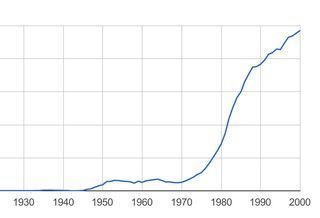
Now, of course, we're all writers. We put our ideas into words and share them with tens or thousands of people, for all time, online. Our words spread.
With the stakes higher than ever, so is our fear.
Consider the alternative to writer's block: the drip. A post, day after day, week after week, 400 times a year, 4000 times a decade. When you commit to writing regularly, the stakes for each thing you write go down. I spent an hour rereading Gary Larson's magical collection, and the amazing truth is that not every cartoon he did was brilliant. But enough of them were that he left his mark.
You can find my most popular posts of the year right here. My new collection, Whatcha Gonna Do With That Duck is now available at finer bookstores online and off. I could never, ever have signed up to write this book, never sat down to create it. But since I had six years to write it, it created itself.
You don't launch a popular blog, you build one.
The writing isn't the hard part, it's the commitment. Drip!
http://sethgodin.typepad.com/seths_blog/2012/12/writers-block-and-the-drip.html?utm_source=feedburner&utm_medium=feed&utm_campaign=Feed%3A+typepad%2Fsethsmainblog+%28Seth%27s+Blog%29


Writer's block and the drip
Why do we get stuck?
Writer's block was 'invented' in the 1940s. Before that, not only wasn't there a word for it, it hardly existed. The reason: writing wasn't a high stakes venture. Writing was a hobby, it was something you did in your spare time, without expecting a big advance or a spot on the bestseller list.

Now, of course, we're all writers. We put our ideas into words and share them with tens or thousands of people, for all time, online. Our words spread.
With the stakes higher than ever, so is our fear.
Consider the alternative to writer's block: the drip. A post, day after day, week after week, 400 times a year, 4000 times a decade. When you commit to writing regularly, the stakes for each thing you write go down. I spent an hour rereading Gary Larson's magical collection, and the amazing truth is that not every cartoon he did was brilliant. But enough of them were that he left his mark.
You can find my most popular posts of the year right here. My new collection, Whatcha Gonna Do With That Duck is now available at finer bookstores online and off. I could never, ever have signed up to write this book, never sat down to create it. But since I had six years to write it, it created itself.
You don't launch a popular blog, you build one.
The writing isn't the hard part, it's the commitment. Drip!
http://sethgodin.typepad.com/seths_blog/2012/12/writers-block-and-the-drip.html?utm_source=feedburner&utm_medium=feed&utm_campaign=Feed%3A+typepad%2Fsethsmainblog+%28Seth%27s+Blog%29


Published on January 01, 2013 17:30
December 27, 2012
Is the death knell ringing for long adult fiction?
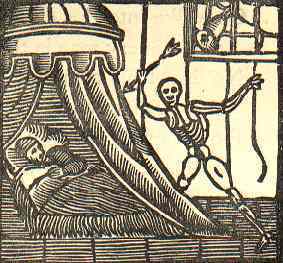
Is the death knell ringing for long adult fiction?
I don't think creative fiction will die, just that the market is getting smaller whilst the number of authors is getting larger.
Those of us with children encourage them to read whilst we ourselves have almost no time to do the same. We read things in snip-its and sound bites, preferring to read a cartoon over a full page of text on a computer screen. As we get older we may have the time to enjoy a book, but maybe by then we'll be too ingrained in our habits to go back to a good book?
And what of our children, who will grow up in a world of shortened prose on facebook, twitter and leads? Will they ever pick up a novel that's longer than 1,000 words?
The way we tell stories is changing, how do novelists adapt to that?


Published on December 27, 2012 21:47
September 30, 2012
Sir Thomas Urquhart

Inventor of over 400 words Sir Thomas was a Scottish writer and translator now has a dedicated blog and Facebook page.


Published on September 30, 2012 20:51
September 25, 2012
The man's DIY keyboard wrist rest

I've been needing a keyboard rest recently and living in Taiwan, as I do, I was surprised to find that none of the local shops sold one (only the small mouse type) and being impatient I stomped my feet and said "I want I want I want" and instead of waiting 2-3 long days for a delivery, I thought I'd make my own.
There is another website with instructions on how to make one if you sew and whilst I may be a reasonably modern man ( changing nappies, doing laundry etc) I have neither the time nor inclination to spend more than 5 minutes on this project.
So in my nearest shop that sells everything I found the following items:
1 x pair of ladies calf length socks (white)
1 x 1kg box of assorted grains. You can use anything you like but these were on special.
Cost: NT$140 or US$4.80(ish) for 2 (yes 2) wrist rests (the other will be used at home.
I already had a plastic bag in the office .

Here's how easy it is:
Turn the sock inside out
Hold the sealed end of the bag at the toe of the sock and with your hand inside the sock (gripping the bag) turn the sock out again.
Fill bagged sock with grain.
Tie bag and tie sock.
It's as easy as that and this blog took longer to write than they took to make.

Published on September 25, 2012 22:42
August 23, 2012
Monied Waters Book Promo Video
Published on August 23, 2012 20:23
August 13, 2012
The worst opening sentences of novels for 2012
[image error]
The 2012 winners of the worst opening sentance of any novel has just been announced by The Bulwer-Lytton Fiction Contest
The Bulwer-Lytton Fiction Contest 2012 is the latest in an annual series of competitions to find the worst-possible opening sentence to a novel.
The competition has been run since 1982, and is sponsored by the English department at San Jose State University. It is named after the Victorian novelist Edward George Bulwer-Lytton, who wrote the immortal opening line "It was a dark and stormy night." All are welcome to enter.
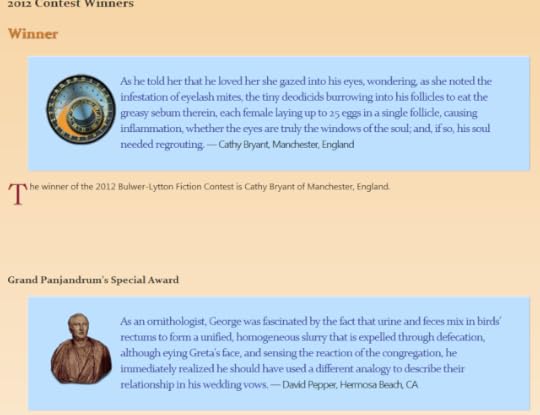
You can read more here

Published on August 13, 2012 20:31
August 6, 2012
OMG!
No, I'm not channeling the thoughts of a 14 year old for a YA novel, although maybe that's not a bad idea. Writing about teenage hormones seems to be a money spinner. But I digress. Text speak maybe relatively new (circa 1994?), but abbreviations in writing have been around for long time, even if they did have to spell out the full meaning later.
Check this out from 1917.
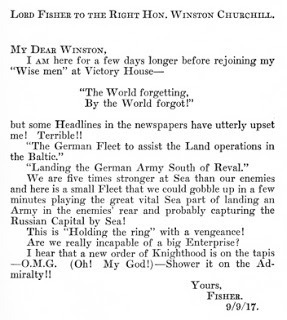
from@LettersOfNote
Whilst most common abbreviations come from the late 80's and early 90's when they were first used in chat room on BBS, terms such as FRAG (used in first person shoot-em ups) have their origins as far back as 1918 before gaining traction in the 1970's and the Vietnam war.


Check this out from 1917.

from@LettersOfNote
Whilst most common abbreviations come from the late 80's and early 90's when they were first used in chat room on BBS, terms such as FRAG (used in first person shoot-em ups) have their origins as far back as 1918 before gaining traction in the 1970's and the Vietnam war.

Published on August 06, 2012 19:28
July 31, 2012
New Harry Patterson Adventure - Monied Waters

The new Harry Patterson novel will be available on Amazon on August 2nd, however if you want to review it in return for a free copy then leave a comment below.

Published on July 31, 2012 22:35
As the Crow Dies audio intro
Published on July 31, 2012 19:38




















